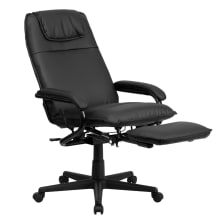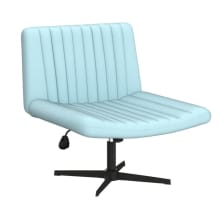These office chairs may help those with ADHD focus
Flexible seating isn’t just for kids
 Credit:
Reviewed / Etta Avenue / Ebern Designs / Flash Furniture
Credit:
Reviewed / Etta Avenue / Ebern Designs / Flash Furniture
Products are chosen independently by our editors. Purchases made through our links may earn us a commission.
Finding the perfect office chair can be challenging for anyone, but it is especially difficult for those with ADHD. While “fidgeting” behaviors aren’t a part of every ADHDer’s symptoms, they are for many. The ability to change position frequently can be a huge benefit to establishing focus, paying attention, and maintaining a happy work life.
While there are some great flexible seating options out there for lounging at home and helping kids focus, many of these can feel unprofessional for adult users. They may be impractical for many office settings, and even feel too casual for those working from home who need to stay on task.
Luckily, there are some great ADHD office chairs out there that look professional while providing an abundance of options for sitting positions. Below you’ll find 13 popular ADHD chairs for adults, alongside tips to ensure you’ve got the right one for your needs.
4 types of ADHD chairs to consider
We’ve broken our suggestions down to a few categories that should help you narrow the style of chair that suits you best.
Standard office chairs with footrests

A footrest is a nice touch for extra comfort and to recline while working.
One of the simplest and cheapest solutions for ADHD-friendly seating is finding a comfortable office chair with a footrest. These chairs come in a variety of styles with different levels of ergonomic support, letting you choose what works best for you while providing options for sitting in ways that maximize your focus.
Consider how much space you have around and under your desk, and make sure your chosen chair works well with any other furniture.
Many of the chairs in this style come with retractable, adjustable, and/or folding footrests, letting you move them out of the way when not in use.

Though pricier than its competitors, this chair is the height of luxury with an extra-wide footrest and superior padding.
Some chairs even have detachable pillows that can be used for a little extra neck or back support as you change positions through the day.

For those who like the support and style of a gaming chair, this one is a sleek choice that comes in a variety of fun colors.
Meditation chairs

Cross-legged seating is non-traditional, but it's actually preferred when it comes to meditation chairs.
Meditation chairs are a popular choice for many people with ADHD because they’re purposefully designed to provide ample space for sitting cross-legged (and in any other strange way you can think of, really).
The Pipersong chair got a lot of social media attention for good reason—it offered a solution that not nearly enough brands had caught on to yet, and consumers were excited.

One of the best-known products in its category, this Pipersong chair offers back support and a platform for you to put your feet and legs wherever you need.
While these chairs can be fantastic for those who are neurodiverse, they do tend to be bulkier than most office chairs. You’ll want to measure and make sure you have space for one before purchasing, as the footrests are not removable and can be hard to fit in especially tight spaces.
Kneeling chairs don’t usually offer a variety of sitting styles, but they do help you maintain a healthy posture, and there are a select few on the market that allow for multiple leg positions.

If you prefer backless chairs, this one might be a more affordable alternative to some of the bigger names.
Chairs without armrests

These office chairs welcome different body types because there are no armrests on either side to confine you.
Armrests can get in the way when you like to switch up how you sit in your chair. They’re often too narrow to sit cross-legged, can cause uncomfortable pressure when one leg is tucked in the chair with you, and may feel claustrophobic to some occupants. We recently reviewed the Pukami Armless Office Desk Chair listed below and appreciated the product for its wide seat and attractive design.
Finding an office chair that is armrest-free can be, well, freeing. They can also be ideal for those with less flexibility and those who take up a little more space in the average chair.

The luxurious, wide seat of this chair is perfect for curling up in any position while still looking professional.

This chair combines the best of style and function, providing angled sides that let you comfortably cross your legs.
If you work at a standing or height-adjustable desk, finding a chair that seats you at the appropriate height is especially important. Luckily, there are plenty of ADHD-friendly office chairs on the market that sit higher than the average 21 inches.

This chair is an affordable option that is simple but highly functional. The seat can raise as high as 22 inches.

With flip-up arms and an adjustable foot ring, this chair is ideal for fidgeting whether you’re sitting, standing, or leaning. As it’s a drafting chair, the seat can raise up to 29 inches.
Balance seats

Filter any remaining hyperactivity with a balance seat that helps you stay engaged.
If you prefer active sitting or want to release excess energy, a seat that involves some balance and allows the user to move can be a great fit. These seats tend to encourage good posture and discourage getting too comfortable or sleepy in especially plush chairs.
While these chairs are likely to stick out the most in an office setting, they’re all still subtle enough to be reasonably workplace appropriate. Plus, for those working from home, these chairs likely won’t be noticeable on video.

This chair is perfect for those who focus best when they can’t fully sink into their seat, as well as those who like to rock as a form of fidgeting.

This Active Learning Stool is great for perching, leaning, and moving as you work in office-friendly fashion.
Many people use a standard yoga ball as a work chair, but these chairs combine the benefits of a yoga ball with the stability of a standard office chair.

If you like the bounce of a yoga ball seat but need some back support, too, this chair offers the best of both worlds.

This is a classier version of perching on a yoga ball, providing the same benefits of movement while also being safer to sit on than a ball that might roll away.
What to look for in ADHD chairs

Certain office chairs cater to the seating preferences of those with ADHD, including design changes for adaptability and comfort.
While every person has their own needs to consider when it comes to work-friendly and ADHD-friendly seating, there are a few factors every shopper should keep in mind when making their purchase.
Prioritize the ability to change position often
Your seat should offer the flexibility to sit however you find most conducive to focus. This might be more limited at an in-person office than a space where you work from home, since you may not be able to fully pretzel yourself into your chair while wearing most traditional work attire.
Generally speaking, you should look for chairs that you can put one or both feet on comfortably and are adjustable in ways that can help you switch up how you’re sitting.
Ergonomic options keep your back positioned well
People with ADHD often have comorbidities such as scoliosis and hypermobility, which can make it extra important to have ergonomic seating options.
Unfortunately, sitting in the ergonomic-approved way, with your back straight and feet on the floor, can feel excruciating for many of us. To avoid that sensation, it’s best to identify where you need the most support and prioritize that in your seat.
Ideally, one should have a chair that supports the body in the “proper” way for bad health days, but that can be flexible for all sorts of strange positions on other days.
For instance, since my back is my main pain point, I tend to look for chairs that support my back that also let me sit in odd positions.
A professional style keeps you productive
Let’s be crystal clear: Flexible seating and other accommodations aren’t unprofessional—they’re easy and necessary steps to help neurodiverse and disabled employees work at their highest potential.
That being said, it’s reasonable for your employer to want you to have the same level of professionalism with your seating as you do with your dress code. For a super casual office, something like a yoga ball might be fine, but for a fancier setup, you might be better off dressing things up a little.
Your chair doesn’t have to be boring, but it should have an aesthetic that suggests you take your work as seriously as those around you.


